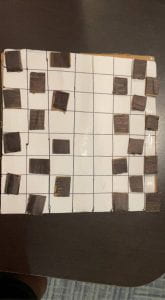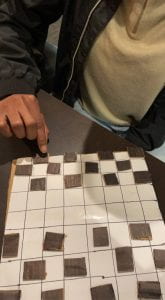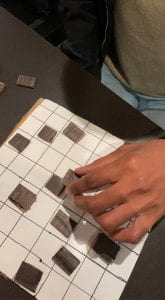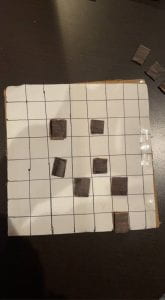Score:
- Play checkers
- Pieces can be of any shape, they just have to be somewhat Identical and of the same color
- Pieces can be stacked on top of each other regardless of whose they are
- Pieces that are stacks cannot be captured
- The game ends when there are 7 (Stacked and/or unstacked) pieces left on the board
Preparation:
- A classic 8×8 chessboard or any 8×8 square grid is used
- Each player uses 12 pieces
- All pieces must be of the same color
- All pieces must be placed at the default positions as used in regular checkers
- 2 players are needed
Artist’s Statement:
The score for Cheesy Checkers was inspired by Yoko Ono and Ludo which is a derivative of the Indian game Pachisi. As the name implies, most of the rules and mechanics are derived from the standard version of checkers. However, in this case rather than following the standard practice of two players going against each other as opponents with the aim of winning the the game of checkers, players are instead working together in tandem to make a piece of art. Persons who follow the score and participate in the activity are in the end more of an artist as compared to being competitors. I feel like although this takes a slightly different route, we can still seem to explore the intentions of Yoko Ono when she was creating white chess. Although in her case there was a bit more freedom for participators in my case, a few more rigid rules purposefully steer the game in a particular direction. For instance, stating that pieces can be stacked regardless of which player claims them and also the instruction that stacked pieces cannot be captured add a completely new element to the game. This in turn focuses more on the collaborative aspect of this score necessitating the communication between players.
The stacking aspect of the game was gleaned from Ludo. In the case of Ludo stacking ones pieces ensures safety and is used as a defensive measure. In this case not only does it do that but once again it leads to cooperation because of the nature of the other rules.

Pre-game Board

Players proceed to move pieces as thought it were normal checkers

Pieces can be stacked

Game ends when there are 7 pieces left
It is interesting to see how different players interpreted the rules and intended to collaborate with each other. One playtest resulted in a case where one player was still adamantly trying to win, hence keeping track of which pieces were “his” and going about the game as though it were a regular game of checkers. This ultimately failed because his “opponent” forcefully collaborated with him by stacking some of her pieces on top of his stacks.
The patterns created by both participators are also interesting, from 3 play tests no 2 patterns were remotely similar which came as a surprise to me. The potential art created from this game is fascinating and hopefully I can find more intriguing interpretations of my score
